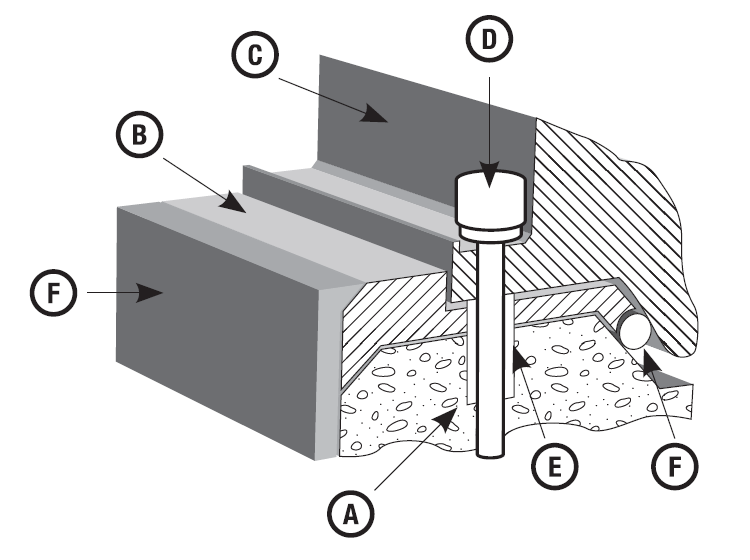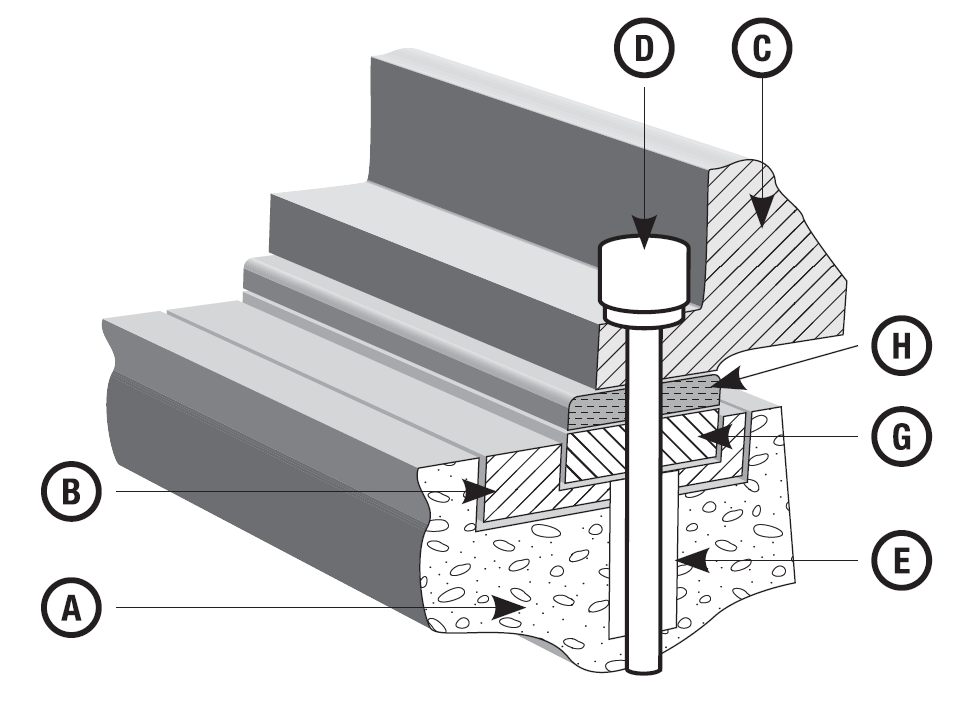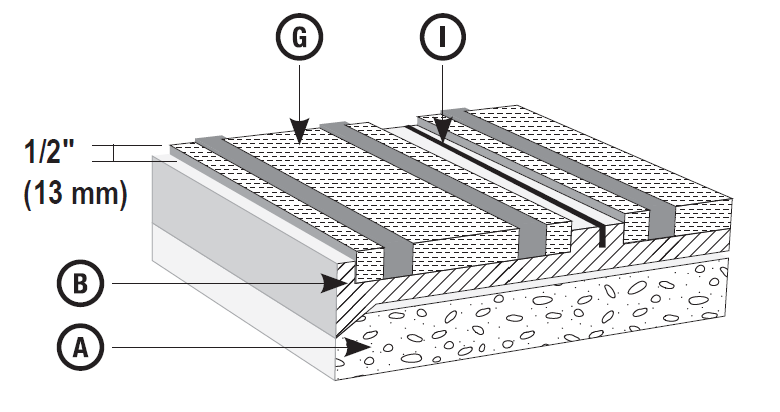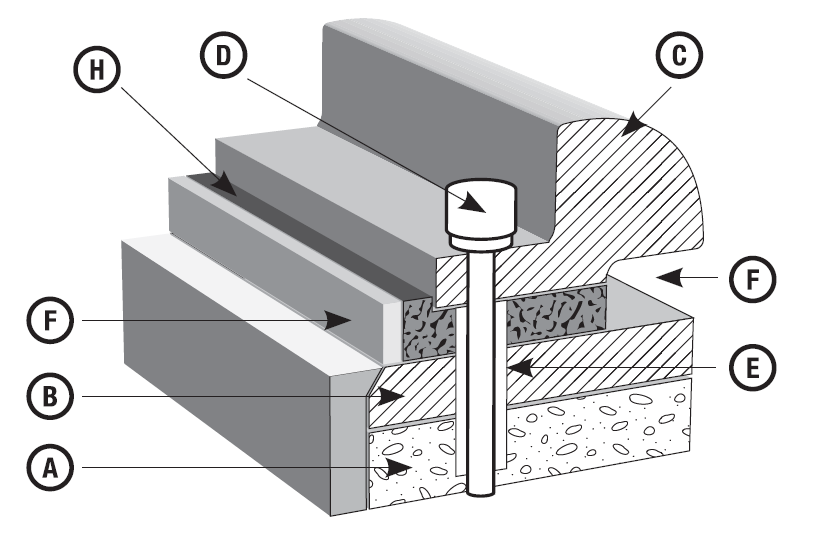
SikaFlow®-648
(formerly MFlow 648)
SikaFlow®-648 is a three-component epoxy resin-based precision grout used to secure critical equipment for proper alignment and transmission of static and dynamic loads. With carefully balanced physical properties and excellent resistance to chemical attack, elevated service temperatures, vibration and torque, SikaFlow®-648 is formulated for easy installation, with good flow characteristics suitable for pouring or pumping in thicknesses up to 6", low dust generation and soap and water clean-up.
SikaFlow®-648 is available in all regions of the world, supported by trained sales and technical personnel with experience in the specification and installation of epoxy grouts on every continent.
- High early and ultimate strengths for rapid turnaround
- Low creep maintains equipment alignment
- Retains physical properties at elevated temperatures
- Low-dusting for added worker comfort and safety
- Very low shrinkage for full baseplate contact
- Excellent flowability with high bearing area for even load distribution
- Variable fill ratio for desired flowability
- Excellent adhesion to steel and concrete for optimum load transfer and vibration dampening
- High chemical resistance
- Excellent freeze/thaw resistance for equipment in low temperature service environments
- Resists water and chloride intrusion for use in wet and aggressive environments
- Resists impact and dampens torque to protect equipment and extend service life
- Extended working time
- Pumpable for maximum productivity if needed
- Durable bond to concrete and steel optimizes load transfer
- Globally available for consistent project results.
Usage
SikaFlow®-648 is used for assembling and fixing of the following items:- Precision alignment of compressors, generators, pumps, fans and electric motors
- Pour-back grouting for post-tensioning cables
- Sole plates
- Crane rail grouting
- Grouting of rolling, stamping, grinding, crushing, drawing and finishing mills, forging hammers and other equipment subject to high torque, impact and vibration
- Grouting of wind turbine tower bases
- Grouting of anchors, bars and dowels
- Chemical processing
- Oil and Gas extraction, refining, processing and distribution
- Power generation
- LNG production, storage and transmission
- Pulp and paper production
- Steel and aluminum manufacturing
- Mining
- Other heavy industry
Advantages
- High early and ultimate strengths for rapid turnaround
- Low creep maintains equipment alignment
- Retains physical properties at elevated temperatures
- Low-dusting for added worker comfort and safety
- Very low shrinkage for full baseplate contact
- Excellent flowability with high bearing area for even load distribution
- Variable fill ratio for desired flowability
- Excellent adhesion to steel and concrete for optimum load transfer and vibration dampening
- High chemical resistance
- Excellent freeze/thaw resistance for equipment in low temperature service environments
- Resists water and chloride intrusion for use in wet and aggressive environments
- Resists impact and dampens torque to protect equipment and extend service life
- Extended working time
- Pumpable for maximum productivity if needed
- Durable bond to concrete and steel optimizes load transfer
- Globally available for consistent project results.
Packaging
54.4 lb unit (0.4 ft3 [0.01 m3])*
| Part A | Resin | 5.5 lb (2.5 kg) pail |
| Part B | Hardener | 1.65 lb (0.75 kg) bottle |
| Part C | Aggregate | 47 lb (21.3 kg) bag |
*All components are packaged in a 6-gallon pail
216.6 lb unit (98.2 kg) (1.7 ft3 [0.05 m3])**
| Part A | Resin | 22.0 lb (10.0 kg) pail |
| Part B | Hardener | 6.6 lb (3.0 kg) bottle |
| Part C | Aggregate | 4 x 47 lb (21.3 kg) bags |
**All components packaged separately. May be ordered as a 3-bag unit, which will yield 1.4 ft3 (0.04 m3). When estimating project requirements, be sure to account for application variables
Color
Dark Grey
Product Details
Shelf Life
24 months if stored at below mentioned storage conditions.
Storage Conditions
Store at ambient temperatures (60 to 80°F [16 to 27° C]), out of direct sunlight, in cool, dry conditions and clear of the ground on pallets protected from rainfall prior to application. The resin parts need to be protected from frost.
Density
| 4-Bag Mix (6.55:1) | 130 lb/ft3 (2,084 kg/m3) |
| 3-Bag Mix (4.92:1) | 123 lb/ft3 (1,971 kg/m3) |
Flash Point
| Part A (Resin) | 419 °F (215 °C) |
| Part B (Hardener) | 325 °F (163 °C) |
Abrasion Resistance
Better than concrete
Impact Strength
Better than concrete
Compressive Strength
| Consistency (Fill Ratio) | 7 Day Ambient | Post Cured |
| 4-Bag Mix (6.55:1) | 14,500 psi (100 MPa) | 16,000 psi (110 MPa) |
| 3-Bag Mix (4.92:1) | 14,000 psi (96 MPa) | 15,000 psi (103 MPa) |
| Time | 50 °F | 77 °F | 90 °F |
| 24 Hours | 4,700 psi (32 MPa) | 10,800 psi (75 MPa) | 12,700 psi (88 MPa) |
| 2 Days | 10,000 psi (69 MPa) | 12,100 psi (83 MPa) | 13,200 psi (91 MPa) |
| 3 Days | 11,000 psi (76 MPa) | 13,000 psi (90 MPa) | 13,600 psi (94 MPa) |
| 4 Days | 12,000 psi (83 MPa) | 13,400 psi (92 MPa) | 13,900 psi (96 MPa) |
*Filled 6.55:1, cured 24 hours at room temperature, post cured 16 hours at 140 ºF, and conditioned 24 hours at test temperature.
Effective Bearing Area
| 1" Clearance | High (>85%)* |
| 2" Clearance | High (>85%)* |
*4-Bag Mix (6.55:1)
Flexural Strength
| 4-Bag Mix (6.55:1) | 4,700 psi (32 MPa) |
| 3-Bag Mix (4.92:1) | 4,300 psi (30 MPa) |
Modulus of Elasticity in Flexure
| 4-Bag Mix (6.55:1) | 2.5 x 106 psi (17.2 GPa) |
| 3-Bag Mix (4.92:1) | 2.3 x 106 psi (15.9 GPa) |
Tensile Strength
| 4-Bag Mix (6.55:1) | 2,000 psi (13.8 MPa) |
| 3-Bag Mix (4.92:1) | 1,800 psi (12.4 MPa) |
Shear Strength
| 2,000 psi (14 MPa)* | Michigan DOT |
*Bond strength to steel at 73 °F (23 °C)
Shrinkage
| 4-Bag Mix (6.55:1) | 0.014 |
| 3-Bag Mix (4.92:1) | 0.031 |
unrestrained; linear, %,
Creep
| Consistency (Fill Ratio) | 400 psi (2.8 MPa) load | 600 psi (4.1 MPa) load |
| 4-Bag Mix (6:55:1) | 3.8 x 10-3 | 4.2 x 10-3 |
| 3-Bag Mix (4:92:1) | 4.0 x 10-3 | 4.9 x 10-3 |
Coefficient of Thermal Expansion
| 4-Bag Mix (6.55:1) | 18 x 10-6 in/in/°F (32.2 x 106 cm/cm/°C) |
| 3-Bag Mix (4.92:1) | 20 x 10-6 in/in/°F (36 x 106 cm/cm/°C) |
Flow Rate
| Clearance | Back of Box | Full Plate Contact |
| 1" | 11 min* | 13 min* |
| 2" | 4 min, 45 sec* | 5 min* |
*4-Bag Mix (6.55:1)
Application
Pot Life
| Temperature | Time |
| 90 °F (32 °C) | 50-60 min |
| 70 °F (21 °C) | 90-120 min |
| 50 °F (10 °C) | 120-150 min |
APPLICATION INSTRUCTIONS
Figure 1 - Regular Equipment

Figure 2 - Engine with Oil Pan

Figure 3 - Rail or Soleplate

Figure 4 - Typical Rail with Expansion Joint Section

Figure 5 - Typical Epoxy Chock Application

NOTES ON INSTALLATION
-
Do not add solvent, water, or any other material to the grout. Do not alter the resin or hardener proportions.
-
Contact your local representative for a pre-job conference to plan the installation.
-
For guidelines on specific anchor-bolt applications, contact Technical Service.
-
Always use a head box when placing less than 1" (25 mm) depths.
-
Substrate temperature must be greater than 50° F (10° C).
-
Cold material will exhibit decreased flowability and reduced strength development.
-
When using SikaFlow®-648 in post-tensioning anchorages, always use the standard aggregate load of 6.55:1.
-
Minimum placement thickness is ½" (13 mm). Contact Technical Service before placing lifts more than 6" (152 mm) in depth.
-
Chamfering the concrete edge helps reduce thermal cracking. Following proper installation procedures also reduce the potential for cracking.
-
For professional use only; not for sale to or use by the general public.
-
Make certain the most current versions of product data sheet and SDS are being used; visit https://usa.sika.com/ to verify the most current versions.
-
Proper application is the responsibility of the user. Field visits by Sika personnel are for the purpose of making technical recommendations only and not for supervising or providing quality control on the jobsite.
EQUIPMENT
- If rust scale is present, abrade the bonding surfaces of the base to be grouted; it must be free of coatings, wax, grease, or scale. Mechanical methods, such as grinding or sanding, will suffice, but do not produce as high a bond strength as sandblasting.
- Primer should be used ONLY when a long delay between cleaning and grouting could allow excessive rusting or contamination. If the base must be primed, use Sikadur-32 Hi-Mod.
- The grout should come up at least ¾" (19 mm) onto the equipment. Protect the area above it with masking tape.
- To facilitate cleanup, wax or cover all surfaces where the grout may splash or spill.
SURFACE PREPARATION
- Cure the foundation until design strength of the concrete is achieved and foundation is dry. Use the recommended procedure according to ACI 351.1R, Grouting Between Foundations and Bases for Support of Equipment and Machinery.
- The surface to be grouted must be clean, strong, and roughened to a CSP of 5–9, following ICRI Technical Guideline No. 310.2 to permit proper bond. Do not use a bushing hammer.
- Chamfer the edge of the concrete 45 degrees to about a 2" (51mm) width.
- If an anchor bolt sleeve is to be filled, be sure all water is removed. Use a siphon, vacuum pump, or rubber hose and bulb. Remove the residual moisture by either forced air or evaporation.
- Seal the anchor bolt hole with felt, foam rubber, or other means.
- Cover all shims and leveling screws with putty or clay to keep the grout from adhering. Use model clay, glazing putty, or anything with a putty consistency that will stick but not harden. Shims or jack pockets may be formed with wood, and forms filled with damp sand.
- Remove shims or jack screws after the grout cures.
- Shade the foundation from direct sunlight for at least 24 hours before and 48 hours after grouting.
MIXING
-
Aggregate must be completely dry.
-
Precondition all components to 70° F (21° C) for 24 hours before using.
-
Pour the hardener (Part B) into a pail of grout resin (Part A) and stir by hand with a spatula or paint stir paddle until well mixed to a uniform amber color.
-
Pour the mixture into a horizontal shaft mortar mixer or a Kol type mixer without delay.
-
Add the grout aggregate, one bag at a time, and mix only until aggregate is completely wetted out to avoid air entrapment. The first batch may be slightly less fluid than later batches because some of the resin is retained on the walls of the mixer. Withholding ½–1 bag of aggregate from the first batch of a full unit will compensate for lost resin. Note: always add aggregate to the mixer after the premixed liquids have been poured in.
| Temperature | 1.7 ft3 unit very thin pours or very long distance | Standard pours |
| > 90° F | — | — |
| 70 to 90° F | Up to ½ bag | — |
| 50 to 70° F | ½ to 1 bag | ½ bag |
APPLICATION
Lengths of metal strapping laid in the formwork prior to placing may be necessary to assist grout flow over large areas and in compacting and eliminating air pockets. Have sufficient manpower, materials and tools to make mixing and placing rapid and continuous. Where grout must flow some distance, make the initial batch slightly more fluid or flowable than required; this lubricates the surfaces and avoids blockage of the grout that follows. The grout shall be poured continuously and from one side only, to avoid entrapment of air while grouting. Maintain a constant hydrostatic head, preferably of at least 4”. On the side where the grout has been poured, allow 4” clearance between the side of the form and the base plate of the machine. On the opposite side allow 2”- 4” clearance between the formwork and the base plate. Due to differences in temperature between the grout under the base plate, and exposed shoulders that are subject to more rapid temperature changes, debonding and / or cracking can occur. Avoid shoulders wherever possible. If shoulders are required, they should be firmly anchored with reinforcing to the substrate to prevent debonding.
Make sure grout fills the entire space to be grouted and remains in contact with the plate throughout the entire grouting placement.
Note: Do not use vibrator for placing the grout!
COLD-WEATHER CURING
For cold weather grouting use SikaFlow 640 Accelerator. Refer to the SikaFlow 640 Accelerator PDS.
- The foundation and the equipment base will probably be cooler than room temperature unless room temperature has been constant for some time. Use the foundation and engine temperature, therefore, in estimating cure time.
- Temperatures vary so radically, day vs. night, atmospheric vs. metal surface, that field judgment must still be used as the final measure. Cured grout should have a solid, almost metallic feel when struck with a hammer. Be sure to check as close to the base of the equipment as possible.
HOT-WEATHER GROUTING
- Special care must be exercised when grouting at elevated temperatures, to reduce risks of premature hardening and subsequent cracking.
- If the packaged grout is above 90° F (32° C), chill the sealed pails of grout resin in a tub of ice or cover the pails with water-soaked burlap to cool the grout to 70° F (21° C).
- Provide shade from direct sunlight for at least 24 hours before and 48 hours after grouting.
COLD-WEATHER GROUTING
- Temperatures below 60° F (16° C) make the grout stiff and hard to handle and significantly increase the cure time. The baseplate and foundation may be much cooler than room temperature. In cold weather, store materials in a warm place. For best handling, the temperature of the grout components and mixing equipment should be at least 70° F (21° C).
- When baseplate and foundation temperatures (measured by a contact thermometer) are less than 50° F (10° C), heating of the area may be necessary.
- If heating is required, erect an enclosure around the equipment and foundation to be grouted. Forced air or infrared heaters may be used to obtain the necessary heat to increase the baseplate and foundation temperatures to 50 to 70° F (10 to 21° C). Avoid local hot spots. Apply heat 1–2 days in advance of grouting to achieve uniform baseplate and foundation temperatures. Avoid exposure to exhaust from heating equipment. Remove heat during grout placement.
- For temperatures from 40 to 50° F (4 to 10° C), consider using SikaFlow 640 Grout Accelerator to accelerate strength development.
CLEANING OF TOOLS
After the pour is complete, remove uncured epoxy from the mixer, wheelbarrow and tools with soap and water or a citrus degreaser. Cured material can only be removed mechanically.
